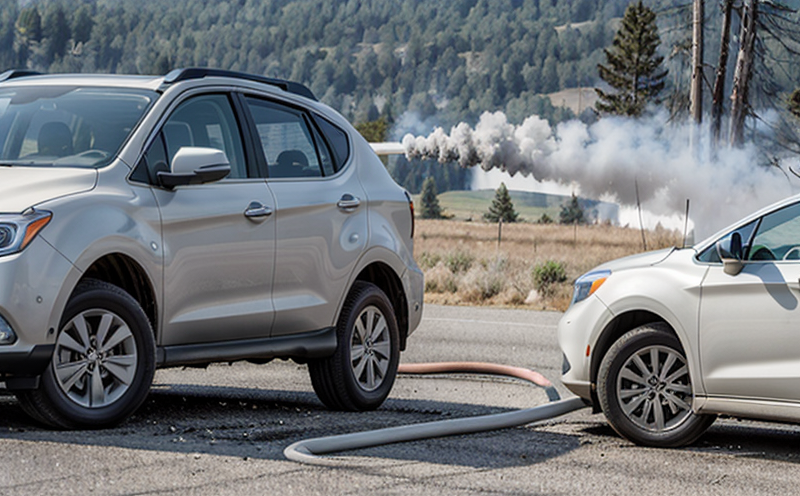Smoke and Gas Emission Testing of Electrical Components
In today’s increasingly complex and interconnected world, electrical components play a crucial role in ensuring safety and functionality across various sectors. Whether it is the automotive industry, building construction, or electronics manufacturing, the reliability and safety of these components are paramount. Smoke and gas emission testing is a critical aspect of this process, helping to identify potential hazards early on.
The purpose of smoke and gas emission testing in electrical components is to assess the amount of toxic gases released during fire scenarios. This test ensures that the materials used in electrical components do not release hazardous levels of smoke or gases upon ignition. The testing is conducted under controlled conditions, simulating real-world scenarios where a component might be exposed to fire.
The test involves placing the electrical component in a specialized chamber and igniting it according to specified methods detailed in international standards such as ISO 13943-2:2018. The chamber measures the volume of smoke produced, the concentration of toxic gases, and their impact on air quality. These parameters are crucial for understanding the potential risks associated with the use of specific materials or designs.
The test results provide valuable insights into the safety profile of the component under fire conditions. Compliance with these standards not only ensures that products meet regulatory requirements but also enhances consumer confidence and trust in the brand. This testing is particularly important for electrical components used in public spaces, such as hospitals, schools, and commercial buildings.
One of the key challenges in conducting this type of test is ensuring accurate measurement under variable conditions. The equipment used must be precise and capable of handling different types of materials and designs. Our laboratory uses state-of-the-art instrumentation that adheres strictly to ISO 13943-2:2018, providing reliable data for our clients.
The process begins with thorough preparation of the sample, ensuring it is representative of the intended application. This includes cleaning, drying, and positioning the component in the test chamber. Once ignited, the system captures all emitted gases using a gas analyzer capable of identifying various compounds such as carbon monoxide (CO), nitrogen dioxide (NO2), and hydrogen chloride (HCl).
The data collected during the test is analyzed to determine compliance with relevant standards. For instance, ISO 13943-2:2018 sets specific limits on smoke density and toxic gas emissions, which are compared against the measured values from our tests. If a component fails any of these criteria, further investigation into its composition or design may be necessary.
Our laboratory also provides comprehensive reporting services, offering detailed reports that outline every aspect of the test process, including the type of materials used, the conditions under which the test was conducted, and the results obtained. These reports are invaluable tools for quality managers and R&D engineers looking to improve product safety or compliance.
In addition to meeting regulatory requirements, there are significant environmental benefits associated with this testing. By identifying components that release harmful substances during a fire, manufacturers can develop more environmentally friendly alternatives. This contributes positively to global efforts towards sustainability and cleaner environments.
- Reduces the risk of toxic emissions affecting indoor air quality.
- Promotes the use of safer materials in electrical components.
- Encourages innovation in developing less hazardous products.
- Fosters a culture of environmental responsibility within industries.
In conclusion, smoke and gas emission testing is an essential step in ensuring the safety and reliability of electrical components. By adhering to international standards like ISO 13943-2:2018, our laboratory provides accurate, reliable data that supports compliance efforts while promoting safer products for everyone.
Applied Standards
The smoke and gas emission testing of electrical components is governed by several international standards designed to ensure consistent quality across different regions. The primary standard used in our laboratory is ISO 13943-2:2018, which provides detailed procedures for conducting the test. This standard covers various types of materials including plastics, rubber, and composites commonly found in electrical components.
ISO 13943-2 specifies the conditions under which the test should be performed, such as temperature, humidity, and duration. It also outlines specific methods for measuring smoke density using photometric techniques and quantifying toxic gases like CO, NO2, and HCl through chromatographic analysis.
Another important standard is ASTM E662-18, which provides additional guidance on the testing of plastics used in electrical components. This standard focuses more specifically on the chemical composition of materials and their flammability properties, complementing ISO 13943-2 by addressing different aspects of material safety.
Both standards are recognized globally for their rigorous methodology and reliability. Adherence to these standards ensures that our testing results are valid across different jurisdictions and industries.
International Acceptance and Recognition
The smoke and gas emission testing of electrical components is widely accepted and recognized internationally due to its critical role in ensuring product safety. Regulatory bodies around the world, including those in Europe (EN 50296), North America (UL 746), Asia-Pacific (AS/NZS 3841:2019), and others, mandate compliance with standards like ISO 13943-2 when it comes to electrical components.
Compliance with these standards is not only a legal requirement but also enhances the reputation of manufacturers who demonstrate their commitment to safety. Many leading brands have incorporated these tests into their quality assurance processes, recognizing the importance of meeting international standards.
The acceptance and recognition of ISO 13943-2 extend beyond mere compliance; it has become a benchmark for excellence in electrical component manufacturing. This standard is widely referenced in various sectors, from automotive to electronics, as a testament to the quality and safety of products.





